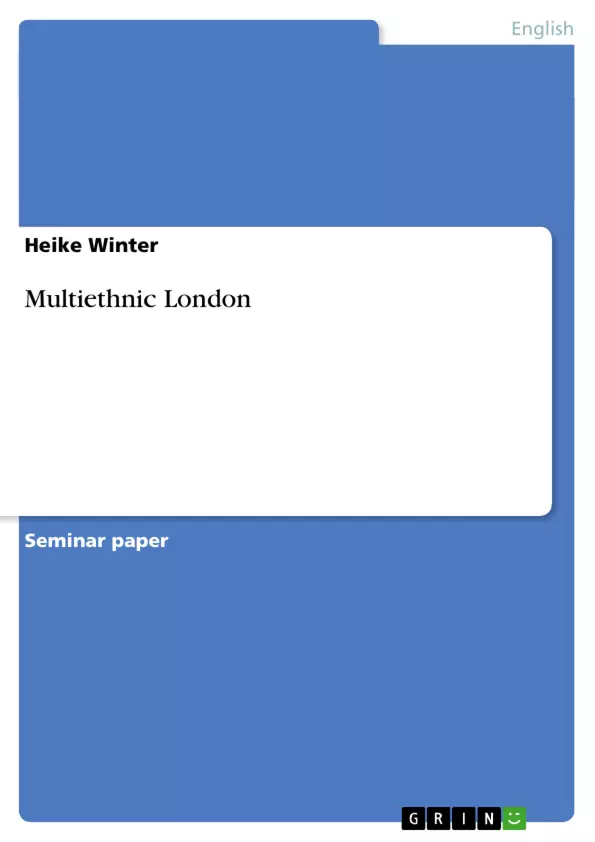The topic of this essay is “Multiethnic London”. The first step necessary when writing about
this topic is to define the term “multiethnic”. According to Collins English Dictionary1
“multiethnic” means “consisting of, relating to, or designed for various different races”. Thus,
this presentation will not focus on the different nationalities living in London but on the
different distinct races residing in the British capital. Moreover, Third Countries will be in the
centre of attention, which are nations outside the current 15 member states of the European
Union.
As many European races do not really differ much from each other and as the many different
communities are listed among the white community, they are not of much relevance today,
when talking about multiethnic London.
With London being one of the most multiracial cities in the world, it is important and
interesting to find out why this is the case and how the different ethnic groups integrate and
contribute to cultural and social life.
The first part of this presentation will concentrate on history and immigration to London and
the corresponding legislation from the beginning of the 20th century onwards.
The next chapter will focus on race relations, both the legislation and the reactions of
Londoners towards the newcomers from all parts of the world.
The third part of this essay will present the most important and largest ethnic minority groups
in London, the Asian and Black communities. Out of personal interest and because I think
they are the most relevant group, I put an emphasis on the various Asian communities.
In the appendix, different reference materials, such as a list of Commonwealth countries, a
table with the different ethnic groups in London and their share of the capital’s population and
a map with the boroughs of London can be found.
1 Collins English Dictionary - 21st century edition, Glasgow 2001
Inhaltsverzeichnis (Table of Contents)
- Introduction
- Immigration and the corresponding legislation
- Immigration and legislation in the first half of the 20th century
- Immigration and legislation before World War I
- Immigration during the World Wars
- Immigration and legislation after World War II
- Immigration and legislation in the second half of the 20th century
- Immigration and legislation after 1948
- Race Relation Acts and reactions of Londoners
- Most significant ethnic groups in London
- Asian Communities
- Indians
- Bangladeshis
- Pakistanis
- Chinese
- Black communities from Africa and the Caribbean
- Black-African
- Black-Caribbean
- Asian Communities
- Immigration and legislation today
Zielsetzung und Themenschwerpunkte (Objectives and Key Themes)
The aim of this essay is to explore the concept of "Multiethnic London," focusing on the diverse racial communities that reside in the British capital. The essay delves into the history of immigration to London and its corresponding legislation from the early 20th century onwards. The essay explores the integration and contributions of different ethnic groups to the cultural and social fabric of London. It highlights the most prominent ethnic minority groups, namely the Asian and Black communities, with a particular focus on the various Asian communities.
- Immigration and Legislation in 20th Century London
- Race Relations and Reactions of Londoners
- Contribution of Ethnic Minorities to London's Cultural and Social Life
- Asian Communities and Their Integration
- Black Communities in London and their Impact
Zusammenfassung der Kapitel (Chapter Summaries)
The first chapter introduces the concept of "multiethnic" and establishes the focus of the essay on racial diversity in London. The second chapter explores the history of immigration to London from the early 20th century, examining legislation and its impact on different ethnic groups. The chapter delves into the pre-World War I era, the impact of the World Wars, and the post-World War II period, including the development of the concept of "British Nationality Law." The third chapter analyzes the most prominent ethnic minority groups in London, with a special emphasis on the diverse Asian communities, including Indians, Bangladeshis, Pakistanis, and Chinese. The chapter also includes a discussion of Black communities from Africa and the Caribbean.
Schlüsselwörter (Keywords)
This essay focuses on key themes such as multiethnicity, immigration, legislation, race relations, cultural integration, Asian communities, Black communities, London, and British history. It examines the impact of immigration and corresponding legislation on London's diverse racial landscape, highlighting the experiences and contributions of various ethnic groups to the city's social and cultural fabric.
- Immigration and legislation in the first half of the 20th century
- Quote paper
- Heike Winter (Author), 2004, Multiethnic London, Munich, GRIN Verlag, https://www.grin.com/document/26938



